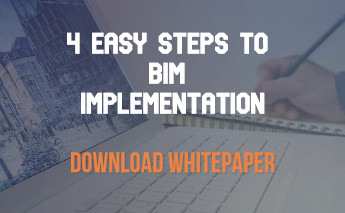|
Getting your Trinity Audio player ready...
|
It may seem to be a daunting task to switch to BIM. The series of BIM Implementation is focused on providing a simple framework which may be helpful for you while getting started and implementing BIM in the organisation.
It is necessary to have a structured and careful approach to ensure successful implementation of BIM practice. This structured approach considers the integrated components related to the business of the firm which starts with leadership and vision and extends to the individuals who shall be using BIM to accomplish their daily task in regards to the project.
1. Study Best Practices to Establish Organizational BIM Standards:
In the cases where the teams are working without guidelines and standards, everyone in the system prepares models in their own way which becomes a challenge while passing these models with the teams or mentioning them to the stakeholders. Most companies have their standards which had been pre-established in terms of technology like AutoCAD, Autodesk, etc but these standards are required to be translated as per BIM guidelines.
By investing in new and updated protocols the organisations may witness positive results in terms of higher productivity, coordination with external partners and team members and also ensure high quality and consistent work performance.
2. Lay-down Your Methodology for the First Project:
It is important to reach BIM implementation is an individual project accessing its own rights. For all the projects to be successful ownership acts as a key and research phase is considered to be very crucial. With help of a few pieces of BIM research, one can finalise the scope of the BIM environment and also understand the manner in which it will affect the current working environment.
Most of the teams beginning with looking for the right technology but their decisions are affected by marketing leading features. By having a word with the ones who have trodden the road before you entered the market, will be more productive. These researches will help you figure out the impact of technology on workflow and the place from where the company can draw maximum benefits.
3. Finalize Your BIM Technology Platform:
It is very important to select and adopt the right BIM strategy. It is important to consider numerous BIM software which is online and then they should be evaluated in terms of BIM implementation goals. By means of comparison of these options in terms of their capability and compatibility, one can build BIM strategy prudentially.
It is required to select the BIM platform at the initial stage of the project to address and find remedies to all related issues. The software platform must have the capability to support all file formats which are required to transfer the information. This process of upgrading or changing the version or platform must be discussed and implemented at the initial stage I order to avoid the interoperability issues at later stages.
4. Create BIM Content Libraries for Model Templates:
The designed objects shall no longer remain graphical; rather they will contain huge ranges of information. Having clear knowledge about the standards one can use it to format or collate the information from the very beginning and thus will avoid problems during the stage of a combination of data. It allows you to design according to business standards, using the model templates, parameter files or the shared library with content and these templates can be used throughout the organisation.
The reference information about the project that includes workspaces, modelling families and database should be brought under consideration to assure that all the project parties are using consistent standards.
5. Migrate Your 2D Data into Your New BIM Application/Tool:
It is necessary to have a strategy in order to migrate the important 2D data to the new BIM platform. The strategic value related to a conversion of 2D files into BIM is done by using the legacy data sources which are necessary for creating BIM models.
Though the BIM platform has a quite different form of working as compared to the 2D application but still there remains some ways to configure BIM in order to replicate the interface standards in regards to 2D data. Controlling line weights for line works which are linked to the new BIM application and migration of 2D details in the BIM software should be considered seriously while 2D data is migrated.
6. Select a Pilot Project, Establish Scope and Schedule Requirements:
Pilot projects have been defined as one of the components which is the part of a well planned BIM implementation plan. The BIM implantation should get complete support from the business. BIM pilot project helps to measure the results of implementation and study the benefits which can be shared with the whole company at the later stage.
It doesn’t matter how much the project weighs, be it multi disciple or single discipline it is necessary to define BIM implementation workflow which can give benefits in long run.
Use of published references and the guides for better implementation of BIM standards and practices is always considered to be a great start point.
To ensure successful implementation the organisations should have strategies to address the needs of business and business values. Having a relationship or bond with some trusted advisor, one who can give guidance about defining and executing the vision can is a stepping stone to the success of the BIM implementation.
In order to get maximum advantage of BIM, it is important to ensure that the executive leadership has the capability of positioning BIM into strategic objectives of the company in long run.



Leave a Reply